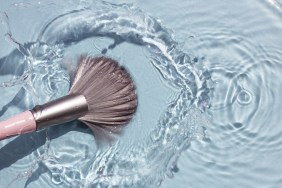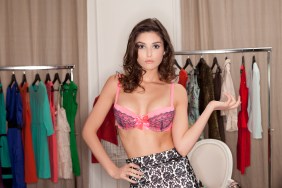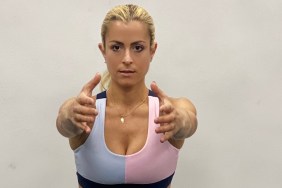Wearing the right bra can have a transformative effect on you and your body. It can make you feel confident and sexy. It can support you, hide your flaws, enhance your assets and more.
But for a majority of us, whether we’re large-breasted, small-breasted or somewhere in between, finding the right bra can be frustrating. And according to the US National Library of Medicine, about 80 percent of us are wearing the incorrect bra size. Seventy percent of us wear bras that are too small, while the other 10 percent wear bras that are too large. Our bras pinch us, gap at the cups or the underwire cuts underneath our breasts, which makes for an uncomfortable and unattractive fit.
Benefits of Wearing the Correct Bra Size
- Gives you the appearance of perkier breasts.
- Helps fight premature aging. No droopy, saggy breasts for you!
- Makes you look slimmer.
- Corrects bad posture and helps you stand up taller and straighter.
- Clothes will look better, feel better and hang better on your body.
But how to measure bra size and find the one that is right for you? To find your ideal bra size, there are two main things to consider: band size (such as 32, 34, 36, etc.) and cup size (A, B, C, etc.). Read on for our handy bra size calculator.
Bra Size Calculator

Band size:
While braless or wearing a non-padded bra, take a measuring tape and measure snugly around your torso, directly under your bust at your rib cage. Make sure the measuring tape is straight and level, and lays flat across your back. When noting the measurement, round to the nearest whole inch. If the rounded number is an even number, add four inches. If the rounded measurement is an odd number, add five inches. (For example, 32 plus 4 equals 36 inches or 29 plus 5 equals 34 inches.) This final calculated sum is your band size.
Band sizes come in even numbers 32, 34, 36, etc., but if you feel that you are between two sizes after calculating your band, let’s say a 33, you should try on both a 32 and 34. Depending on the brand, one size should fit better than the other. Or, for the most perfect custom fit, you can just buy the bigger band size and have a tailor take in the band for you as a relatively inexpensive fix.
Cup size:
Standing with your arms at your side, measure around your body at the fullest part of your bust (usually around your nipples). Round this number to the nearest whole inch. This is your bust measurement. Next, subtract your band measurement from the bust measurement and that difference is your cup size. If the difference is 0, then you are an AA. If it’s between 0.5-1 inch, then you are an A. If it’s 2 inches, then you are a B, 3 inches is a C, 4 inches is a D, 5 inches is a DD or E, 6 inches equals a DDD or F, 7 inches is a G, 8 inches is H, 9 inches is I and 10 inches translates to a J.
For example, 36 inches (bust measurement) minus 34 inches (band measurement) equals 2 inches or a B cup.
But because of variations in sizing among different brands and different bra shapes and styles, Rebecca Apsan, owner of the Manhattan lingerie boutique La Petite Coquette, founder of The Little Flirt and co-author of The Lingerie Handbook and Lessons in Lingerie: Finding Your Perfect Shade of Seduction, believes that the best way to determine the best size for you is by trial and error. She suggests that you go to a trusted lingerie shop and with the guidance of the bra expert, just try on several different sizes and styles from different brands to find the correct size and shape for you. Because even if you fit a 34B perfectly in one brand, you may find that you are actually a 34C in another brand. Or perhaps you find that a 34B demi cup will fit perfectly, but a 34B full-coverage bra will be too big.
When buying the right bra, Apsan believes you should consider fit (does it fit properly and is it right for my body shape and lifestyle?), shape (does it enhance my assets and make me look good?) and feel (how does it feel against my body and how does it make me feel while I’m wearing it?).
Nailing the Bra Fit
- While trying on a bra, to ensure that your assets are completely encased in the cups, lean forward slightly at the waist, then slip on the bra and hook it.
- The bra should fit perfectly when secured on the outermost hook.
- To ensure that your bra lifts your breasts at the right height and gives your assets the necessary support, your nipples should sit midpoint between your shoulders and elbows.
- If there are rolls of flesh around the sides of your bra, then the band is too tight. The band should be snug, but not so tight that you can’t fit a finger underneath.
- If you find that you are always tugging and adjusting the band, then the band is too big and you need to go down a band size.
- If your breasts spill out of your bra, then the bra cups are too small or the bra band is too big.
- If the cups look wrinkly or are too loose, then the cups are too big and you should go down a cup size.
- If your bra has an underwire, the underwire should arc around the breasts; if the wire pokes into them, then you need a larger cup size.
- And generally, the wire should lay flat against you; if it rests on top of the breasts, then go up a cup size.
All in all, the perfect-fitting bra should be snug, but not too snug, the front and back of the band should lay flat against your body and be even and parallel to the ground and it should fit firmly around the back for proper support.
And once you have a bra that fits you well, get refit every few years or whenever necessary. “The average woman will wear several different bra sizes throughout her life,” says Apsan. “As your body changes, so does your bra size. You may have lost some weight. You may have gained some weight. You may have had a baby or are breastfeeding. Or you’ve just simply gotten older and your breasts have fallen or have simply expanded.”
Just remember, the right bra can change your life.







